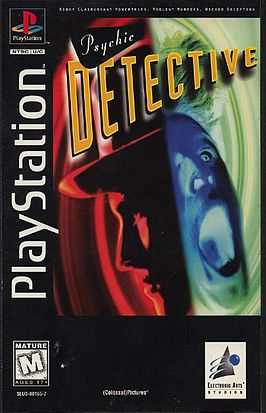Psychic Detective (game)
| Psychic Detective | |
|---|---|
 North American PlayStation cover art | |
| Developer(s) | Colossal Pictures |
| Publisher(s) | Electronic Arts |
| Distributor(s) | Ingram Entertainment |
| Platform(s) | PC, PlayStation, 3DO |
| Release date(s) | PC PlayStation 3DO
|
| Genre(s) | Interactive movie |
| Mode(s) | Single-player |
| Distribution | 3 CD-ROMs |
Psychic Detective is a 1995 video game that used extensive amounts of live-action footage and featuring dozens of professional character actors. It was written by Michael Kaplan and directed by John Sanborn.
The game is set in San Francisco where the player assumes the role of Eric Fox (Kevin Breznahan), a psychic who earns his living doing a magic act in a seedy nightclub. One night, he is approached by the exotic Laina Pozok (Beata Pozniak), who senses that Eric is more powerful than he imagines. She trains Eric to "hitch hike" into people's minds. He sees what his subject sees, and hears what his subject hears; meanwhile, his body continues to interact with the world around him in an "automatic pilot-like" state. Laina hires Eric to attend a wake being held in honor of her father, who has died under mysterious circumstances.
Gameplay
The game begins when Eric enters the Pozok household, and is given the choice to remain in his body, or hitch hike aboard any one of a number of characters he encounters. Eric also has the ability to pick up objects and take a psychic reading of them, providing more clues to help solve the Pozok murder case. Before long, Eric is embroiled in a conspiracy involving a powerful religious cult, spies, and family intrigue, and he also has to deal with his growing romantic attachment to Laina. Occasionally throughout the game, Eric obtains access to "psychic collectors" which amplify his abilities and allow him to affect the moods and attitudes of the people around him, but at a cost.
Psychic Detective is generally presented in first person, with icons appearing at intervals on the screen signifying people and objects Eric can interact with. Each game generally takes about 45 minutes to play, however multiple plays are required in order to uncover all aspects of the storyline, and there are a dozen alternate endings possible; depending upon the choices made by the player, many different storylines are uncovered, including one that occurs if the player makes no choices and simply watches events unfold. Occasional cut scenes break the storyline into chapters, but which cut scene is viewed depends upon Eric's actions. The endgame portion of Psychic Detective involves Eric playing a surreal board game against the villain.
History
The game was released on the PC, PlayStation and 3DO. The game includes adult language and sexual content in the PC and 3DO versions, which was censored from the PlayStation version.
The game received mixed reviews on its first release. Arinn Dembo, writing for Computer Gaming World, gave the game 4 stars.[2] GameSpot gave the PC version a 4.7, calling the game "innovative", but asserting that the overabundance of interaction and storyline branches turns the experience into a confusing mess. They concluded "Instead of being like a good movie enhanced by interactivity, Psychic Detective is a more like a movie... clouded with interactive options that eventually detract from the project."[3] Live action footage from Psychic Detective was edited together to create a short film that was shown at a film festival in the mid-1990s.[4]
This game is not to be confused with the Japanese-only Psychic Detective series of adventure games developed by DataWest.
References
- ↑ http://uk.ign.com/games/psychic-detective/ps-526
- ↑ Dembo, Arinn; Looking Through the Mind's Spy: Play Head Games in an Interactive Movie that Lives Up to the Name, p. 120. Computer Gaming World, Issue 144, July 1996
- ↑ Young, Jeffrey Adam (May 1, 1996). PC version review, Gamespot.
- ↑ Executive producer Jim Simmons, quoted on Beata Pozniak's official website, accessed Feb. 14, 2011.